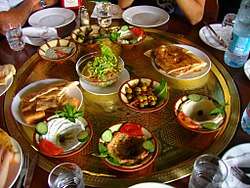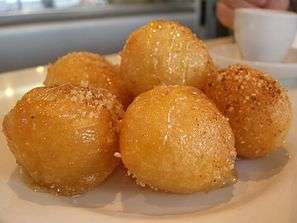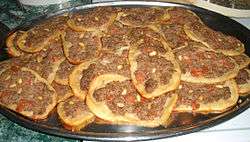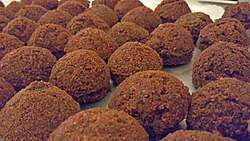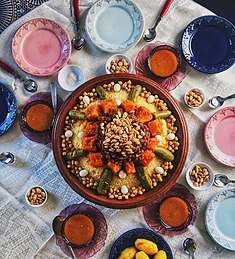Arab cuisine
Arab cuisine (Arabic: المطبخ العربي) is the cuisine of the Arabs, defined as the various regional cuisines spanning the Arab world, from the Maghreb to the Fertile Crescent and the Arabian Peninsula.[1] The cuisines are often centuries old and reflect the culture of great trading in spices, herbs, and foods. The three main regions, also known as the Maghreb, the Fertile Crescent, and the Arabian Peninsula, have many similarities, but also many unique traditions. These cuisines have been influenced by the climate, cultivating possibilities, as well as trading possibilities.
 |
| Part of a series on |
| Arab cuisine |
|---|
|
Regional cuisines
|
|
Salads
|
|
Holidays and festivals
|
|
Medieval cuisine
Breads
The white bread barazidhaj was made with high-quality wheat flour, similar to raqaq bread but thicker, the fermented dough was leavened usually with yeast and "baker's borax" (buraq) and baked in a tandoor. One poetic verse describing this bread:[2]
"In the farthest end of Karkh of Baghdad, a baker I saw offering bread, splendidly marvelous.
From purest essence of wheat contrived. Radiant and absolute, you may see your image reflected, crystal clear.
Barazij rounds glowing with lovely whiteness, more playful than gorgeous singing girls,
They look like crystal trays, and were they indeed so, they would have served us as plates.
Raqaq bread was made in two varieties, labiq (soft, thin flatbreads) and jarmazaj (dry, thin bread flavored with tamarisk seeds).
Sauces
Numerous recipes for sauces (sibagh) have survived from historic Arabic cookbooks. Kitab al-Tabikh gives several recipes to be served with roasted fish, attributed to the various sources. To Ibrahim ibn al-Mahdi are credited two sibagh recipes. One prepared by adding rue, caraway, thyme, asafetida and cassia to mustard sauce, and another made by mashing vinegar soaked raisins with garlic, walnut, mustard, vinegar, and seasonings like asafetida and anise. From the seventh Abbasid caliph Al-Ma'mun's recipe collection comes a sibagh made with whey, walnut, garlic, olive oil and murri. There are similar recipes meant for poultry dishes prepared with seasonings like ginger, pomegranate, spikenard and cloves. A surviving poem about sibagh is attributed to Caliph Al-Mu'tamid:[3]
The concept of sibagh is so subtle that none other than the smart can fathom.
Walnut and garlic with yogurt whey are the most you may need for it.
Or make it with vinegar, mahrut, and coriander. But with anjudhan it will be even better.
If not, then mustard and garlic mixed with anjudhan and onion, equal parts, will make your relish.
Or with just vinegar and onion eat your fish and it will still be a tasty dish.
Sweets
Described as the "food of kings" and "supreme judge of all sweets", lauzinaj was an almond-based confection that had entered medieval European cuisine by the 13th-century from Andalusian influence, returning Crusaders and Latin translations of cookery books. There are two versions of the dish known from medieval texts:[4]
- Lauzinaj mugharraq or "drenched lauzinaj", this dish is believed to be an earlier version of the Ottoman dish baklava. It was made by filling thin pastry dough with a mixtur e of ground almond (and sometimes other nuts like pistachio or walnut), rosewater, and sometimes luxury flavorings like mastic, ambergris, or musk.
- Lauzinaj yabis was made with ground almonds cooked in boiling honey or sugar until reaching a taffy like consistency. The raw version, closer to marzipan in consistency, was made by blending the almonds with sugar and flavoring with camphor, musk and rosewater. The finished confection was molded into animal or other shapes, or cut into squares and triangles.
Vegetables
Vegetables included leeks, endive, melilot, fenugreek, onions, purslane, Jew's mallow and radish.[5] Boiled asparagus was served with olive oil and murri. The cooking water was sweetened with honey and seasoned with cilantro, rue, anise and black pepper, and used as a beverage either by itself with honey or added to wine.[6] Some vegetables were consumed raw, but the following were usually boiled: asparagus, cauliflower, white soy beans, leeks, orach, a variety of mushroom known as ghushina, chard, cabbage, carrot, turnip, fresh fennel and eggplant.[7]
Some vegetable dishes were served cold. One example of such a dish is eggplant with fried onion, fresh herbs and olive oil dressed with fermented sauces, vinegar and caraway. There were several cold eggplant dishes that were similar some made with smoked eggplant, adding nuts like ground walnuts or almonds, and sometimes different seasonings like saffron, cassia, galangal and so on.
A dish for fried carrots with fresh herbs, dressing and spices was described by the poet Kushajim:[8][9]
Dinars of carnelian and gold in a vessel so delicate, it may almost melt and flow.
All radiating with luster like carnelian shimmering on pearls.
In the vessel harmoniously combined, here together and there disperse.
The spices emitting fragrance like wine mingled with sweet breeze.
On top are pearls and silver decked with gems,
Which the cook delicately fashioned, a gorgeous dish with flavor and perfume.
The scattered rue is flowers of turquoise gems, vibrantly green,
Jiggling with murri and olive oil, ebbing and flowing with sheen.
Diet and foods
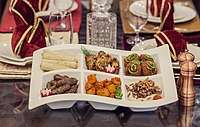

The Arab cuisine uses specific and sometimes unique foods and spices. Some of those foods are:
- Meat: lamb and chicken are the most used, followed by beef and goat. Other poultry is used in some regions, and fish is used in coastal areas including the Mediterranean sea, Atlantic Ocean or the Red sea. Pork is completely prohibited for Muslim Arabs, being both a cultural and religious taboo (Haram) and prohibited under Islamic law; many Christian Arabs also do not eat pork.[10]
- Dairy products: dairy products are widely used, especially yogurt, buttermilk and white cheese. Butter and cream are also used extensively.
- Herbs and spices: The amounts and types used generally varies from region to region. Herbs and spices include: sesame, saffron, black pepper, allspice, turmeric, garlic, cumin, cinnamon, parsley, coriander and sumac. Spice mixtures include baharat, ras el hanout, za'atar, and harissa.
- Beverages: hot beverages are served more often than cold, coffee being at the top of the list in the Middle-eastern countries and tea at top of the Maghreb countries. In Jordan, Palestine, Egypt, some parts of Syria, Morocco, and Algeria, tea is much more prevalent as a beverage. Other Arabic drinks include Andalucian horchata and Maghrebi avocado smoothie.
- Grains: rice is the staple and is used for most dishes; wheat is the main source for bread. Bulgur and semolina are also used extensively. According to historic recipes known from Arabic cookbooks, grains were primarily used to made porridge and pasta type dishes in Arab cuisine until the 12th century. Two types of pasta were known:itriya, a short dry noodle of Greek origin similar to orzo, and rishta, a hand cut fresh noodle of Persian origin. By the 13th century, the Turkic style tutmaj and salma noodles had entered the cuisine.[11]
- Legumes: lentils are widely used in all colours, as well as fava beans, peanuts, chickpeas (garbanzo beans), scarlet runner beans, green peas, lupini beans, white beans, and brown beans.
- Vegetables: Arab cuisine favors vegetables such as carrots, eggplant (aubergine), zucchini (courgette), artichokes, okra, onions, and olives. Potatoes are also eaten as vegetables in Arab culture.
- Fruits: Arab cuisine favors fruits such as pomegranate, dates, figs, oranges, citruses, watermelons, cantaloupe, honeydew melon, grapes, peaches, and nectarines.
- Nuts: almonds, pine nuts, pistachios, and walnuts are often included in dishes or eaten as snacks.
- Greens: parsley, coriander and mint are popular as seasonings in many dishes, while spinach and mulukhiyah (leaves from the plant of the Corchorus genus) are used in cooked dishes.
- Dressings and sauces: The most popular dressings include various combinations of olive oil, lemon juice, parsley, or garlic, as well as tahini (sesame paste). Labaneh (strained yogurt) is often seasoned with mint, onion, or garlic, and served as a sauce with various dishes.
Culture
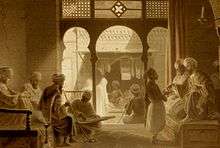
Essential to any cooking in the Arab world is the concept of hospitality and generosity. Meals are generally large family affairs, with much sharing and a great deal of warmth over the dinner table. Formal dinners and celebrations generally involve large quantities of lamb, and every occasion entails large quantities of Arabic coffee or Arabic tea.
Khaleej/Iraqi
Coffee ceremony: In the Khaleej (Arab) region, a visitor is greeted by a great table of dried fruits, fresh fruits, nuts and cakes with syrup. Dried fruits include figs, dates, apricots and plums. Fresh fruits include citruses, melons and pomegranate. Arabic Coffee is served the most, but Arabic tea is also a great refresher. Spices are often added in the coffee or other drinks.
Dinner guests: In the Khaleej (Arab) region, a visitor might expect a dinner consisting of a very large platter, shared commonly, with a vast amount of spiced rice, incorporating cooked spicy lamb or chicken, or both, as separate dishes, with various stewed vegetables, heavily spiced, sometimes with a tomato-based sauce. Different types of bread are served with different toppings specific to the region. Tea would certainly accompany the meal, as it is almost constantly consumed. Coffee would be included in the same manner.
Maghreb
Tea/coffee ceremony: In the Maghreb region, a visitor might expect a table full of bread-like snacks, including Msemen, Baghrir and other stuffed breads. These are served with honey, rosewater or olive oil. There are also many different cookies and cakes included accompanied by plates with different kinds of nuts. Arabic coffee and Mint tea is often served with it in a traditional Maghrebian teapot.
Dinner guests: In the Maghreb region, a visitor might expect a table with different kinds of stews, also called Marqas or Tajines. Dishes such as couscous or other semolina based dishes are much appreciated as well. These main dishes are accompanied by smaller mezze-like plates with salads, sauces and dips. Breads such as Msemen and Khobz are used to eat the stews.
Levantine
Coffee/ tea ceremony: In an average Arab Levantine household, a visitor might expect a table full of Mezzes, breads topped with spices including Za'atar and nuts. In the Levant, Arabic coffee is a much loved beverage, but Arabic tea is also much loved in Jordan and Palestine.
Dinner guests: In the Levant, a visitor might expect a table with different kinds of mezzes, nuts, dips and oils. Mezzes include Hummus, Baba ghanoush, Falafel, Kibbeh, Kafta, smoked vegetables and Tabouli salads. The nuts can differ from almonds to walnuts, with different spice coatings. The dips and oils include hummus and olive oil.
Regional differences
There are many regional differences in the Arab cuisine. For instance, mujadara in Syria and Lebanon is different from mujadara in Jordan and Palestine. Some dishes, such as mansaf (the national dish of Jordan), are native to certain countries and rarely, if ever, make an appearance in other countries. Unlike most Western recipes, cinnamon is used in meat dishes, as well as in sweets such as baklava. Dishes including Tajine and Couscous can differ from Morocco to Libya, each having their own unique preparation. Other dishes, such as the Arabo-Andalucian Bastilla or Albondigas have different traditional spice mixes and fillings.
Many Arabic food words are borrowed from Aramaic, the language spoken by the Christian Nabataean inhabitants of Iraq and Syria.[11]
Structure of meals
There are two basic structures for meals in the Arab World, one regular schedule during most of the year and a second one that is unique to the month of Ramadan in which observant Muslims fast during the day.
Year round
Breakfast
Cafés often serve croissants for breakfast. Breakfast is often a quick meal, consisting of bread and dairy products, with tea and sometimes jam. The most common breakfast items are labneh and cream (kishta, made of cow's milk).
Lunch
Lunch is considered the main meal of the day, and is traditionally eaten between 1:30pm and 2:30pm. It is the meal for which the family comes together. Rarely do meals have different courses; however, salads and mezze are served as side dishes to the main meal. The platter usually consists of a portion of meat, poultry or fish, a portion of rice, lentils, bread and a portion of cooked vegetables, in addition to the fresh ones with the mezze and salad. The vegetables and meat are usually cooked together in a sauce (often tomato, although others are also popular) to make maraqa, which is served with rice. Most households add bread. Drinks are not necessarily served with the food; however, there is a very wide variety of drinks such as shineena (or laban), karakaden, Naqe'e Al Zabib, Irq Soos, Tamr Hindi, and fruit juice, as well as other traditional Arabic drinks. During the 20th century, carbonated soda and fruit-based drinks have also become very popular.
Dinner
Dinner is traditionally the lightest meal, although in modern times, dinner has become more important with regards to entertaining guests due to the hours of the workday.
Ramadan
Iftar
Iftar (also called Futuur), or fast-breaking, is the meal taken at dusk when the fast is over. The meal consists of three courses: first, diners eat a date due to Islamic tradition. This is followed by a soup or anything they would like, the most popular being lentil soup, but a wide variety of soups such as chicken, oats, freeka (a soup made from whole wheat and chicken broth), potato, maash, and others are also offered. The third course is the main dish, usually eaten after an interval, when Maghreb prayer is conducted. The main dish is mostly similar to what is served in lunch year-round, except that cold drinks are served.
Suhur
Suhur is the meal eaten just before dawn, when fasting must begin. It is eaten to help the person make it through the day with enough energy until dusk.
Sweets
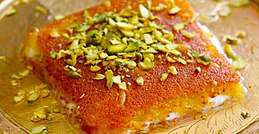
In addition to the two meals eaten during Ramadan (one for dinner and one for Suhur before dawn), sweets are consumed much more than usual during the month of Ramadan; sweets and fresh fruits are served between these two meals. Although most sweets are made all year round such as Kanafeh, baklava, and Basbousa, some are made especially for Ramadan, such as Qatayef.[12]
Regional Arab cuisines
Arabian Peninsula


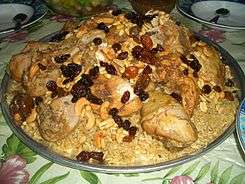
The cuisine of Eastern Arabia today is the result of a combination of diverse cuisines, incorporating Levantine and Yemeni cuisines.[13] Bukhari rice (رز بخاري) (Ruz al Bukhari) is a dish eaten in the Hejaz, Saudi Arabia. It is a rice with spicy tomato sauce, flavoured chicken and a fresh salad. It is a very popular dish in the Hejaz district of Saudi-Arabia.
Kabsa (كبسة) or makbūs (مكبوس) is a traditional mixed rice dish in many Arab states of the Persian Gulf that originates from Saudi Arabia. It is made of rice (usually long-grain, almost always basmati), meat, vegetables, and a mixture of spices. The spices used in kabsa are largely responsible for its taste; these are generally black pepper, cloves, cardamom, saffron, cinnamon, dried lime (also known as black lime), bay leaves and nutmeg.[14] The meats used are usually chicken, goat, lamb, camel, beef, fish or shrimp. Kabsa is popular in countries around the Persian Gulf and Iran's Khuzestan Province in Iran.
The cuisine of Yemen is rather distinct from other Arab cuisines. Like most other Arab cuisines, chicken, goat, and lamb are eaten more often than beef. Fish is eaten mostly in coastal areas. However, unlike most Arab countries, cheese, butter, and other dairy products are less common, especially in the cities and other urban areas. As with other Arab cuisines, the most widespread beverages are tea and coffee; tea is usually flavored with cardamom, clove, or mint, and coffee with cardamom. Karakaden, Naqe'e Al Zabib, and diba'a are the most widespread cold beverages.
Although each region has their own variation, saltah (سلتة) is considered the national dish of Yemen. The base is a brown meat is called maraq (مرق), a dollop of fenugreek froth, and sahawiq (سحاوق) or sahowqa (a mixture of chili peppers, tomatoes, garlic, and herbs ground into a salsa. Rice, potatoes, scrambled eggs, and vegetables are common additions to saltah. It is eaten with flat bread known as mulawah, which serves as a utensil to scoop up the food. Other dishes widely known in Yemen include aseed, fahsa, thareed, samak mafi, mandi, fattah, shakshouka, shafut, bint al-sahn, kabsa, jachnun, nasi kebuli, harees and Hyderabadi haleem.[15][16][17]
Mashriq
.jpg)
Levantine cuisine is the traditional cuisine of the Fertile Crescent. Although now divided into Syria, Lebanon, Jordan, Iraq, Egypt, and Palestine, the region has historically been more united, and shares most of the same culinary traditions. Although almost identical, there is some regional variation within the Levantine area.
Dishes include olive oil, za'atar, and garlic, and common dishes include a wide array of mezze or bread dips, stuffings, and side dishes such as hummus, falafel, ful, tabouleh, labaneh, and baba ghanoush.
It also includes copious amounts of garlic and olive oil, often seasoned with lemon juice—almost no meal goes by without including these ingredients. Most often foods are either grilled, baked, fried, or sautéed in olive oil; butter and cream are rarely used, other than in a few desserts. Vegetables are often eaten raw or pickled, as well as cooked. While the cuisine does not boast a multitude of sauces, it focuses on herbs, spices, and the freshness of ingredients.
Bedouin kitchen
The Bedouins of the Arabian Peninsula, Middle-East and North-Africa relied on a diet of dates, dried fruit, nuts, wheat, barley, rice, and meat. The meat comes from large animals such as cows, sheep, and lambs. They also eat dairy products: milk, cheese, yoghurt, and buttermilk (Labneh). The bedouins would also use many different dried beans including white beans, lentils, and chickpeas. Vegetables that were used a lot among the bedouins are variants that could be dried, such as pumpkins, but also vegetables that are more heat-resistant, such as aubergines. They would drink a lot of fresh Verbena tea, Arabic tea, Maghrebi mint tea, or Arabic coffee. A daily break to freshen up with drinks is a much loved tradition. The bread that is eaten a lot is called Khobz as well as Khaleej, in the Maghreb regions. Dishes such as Marqa, Stews, Tajines were prepared traditionally among the bedouins. Breakfast consisted of baked beans, bread, nuts, dried fruits, milk, yoghurt, and cheese with tea or coffee. Snacks included nuts and dried fruits.
Levant
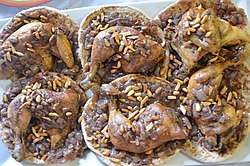
.jpg)
In Palestine and Jordan, the population has a cooking style of their own, involved in roasting various meats, baking flat breads, and cooking thick yogurt-like pastes from goat's milk.
Musakhan is a common main dish, famous in northern Jordan, the city of Jerusalem, and northern West Bank. The main component is taboon bread, which is topped with pieces of cooked sweet onions, sumac, saffron, and allspice. For large dinners, it can be topped by one or two roasted chickens on a single large taboon bread.
The primary cheese of the Palestinian mezze is Ackawi cheese, which is a semi-hard cheese with a mild, salty taste and sparsely filled with roasted sesame seeds. It is primarily used in Kenafah
Maqluba is another popular meal in Jordan and central Palestine. Mujaddara, another food of the West Bank, as well as in the Levant in general, consists of cooked green lentils, with bulghur sauteed in olive oil. Mansaf is a traditional meal, and the national dish of Jordan, having roots in the Bedouin population of the country. It is mostly cooked on special occasions such as Ramadan, Eid ul-Fitr, a birth, or a large dinner gathering. Mansaf is a leg of lamb or large pieces of mutton, on top of a markook bread that has been topped with yellow rice. A type of thick dried yogurt made from goat's milk, called jameed, is poured on top of the lamb and rice to give it its distinct flavor and taste. The dish is garnished with cooked pine nuts and almonds.
Levantine cuisine is also famous for its wide range of cheeses, including Shanklish, Halloum, and Arisheh. Kishk is also a famous Syrian soup, alongside many soups made of lentils. Lebanese food also has a wide range of dips including Hummous, Baba Ghannouj, and Labneh, and also caters many raw meat dishes. Syrian food could be either extremely vegetarian or a meat lover's paradise. Lemon, oregano, za'atar, paprika, and various other Mediterranean spices and herbs are used in Syrian cuisine. To top it off,
Levantine cuisine also incorporates wines made in Lebanon, Syria, Jordan and Palestine and the Levantine equivalent of the Greek Ouzo, known as Arak.
Mesopotamia
Iraq is where the first cookbook was ever recorded in history, historically in Baghdad and Mesopotamia. Iraq is one of the oil-rich Arab countries surrounding the gulf and is also part of the Mashriq sharing similarities in cooking and cuisines between both the surrounding regions of the Arab world. Iraqi cuisine mainly consists of meat, rather than appetizers. In Iraqi cuisine, the most common meats are chicken and lamb. The national dish of Iraq is the Masgouf fish, usually enjoyed with grilled tomatoes and onions. Iraqi cuisine uses more spices than most Arab cuisines. Iraq's main food crops include wheat, barley, rice, vegetables, and dates. Vegetables include eggplant, okra, potatoes, and tomatoes. Pulses such as chickpeas and lentils are also quite common. Common meats in Iraqi cooking are lamb and beef; fish and poultry are also used.
Soups and stews are often prepared and served with rice and vegetables. Biryani, although influenced by Indian cuisine, is milder with a different mixture of spices, and a wider variety of vegetables, including potatoes, peas, carrots, and onions. Dolma is also one of the most popular dishes.
The Iraqi cuisine is famous for its extremely tender kebab, as well as its tikka. A wide variety of spices, pickles, and amba are also extensively used.
Egypt
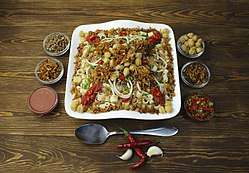
Egypt has a very rich cuisine with many unique customs. These customs also vary within Egypt itself, for example, in the coastal areas, like the coast of the Mediterranean Sea and Canal, the diet relies heavily on fish. In the more rural areas, reliance on farm products is much heavier. Duck, geese, chicken, and river fish are the main animal protein sources. While Egyptians eat a lot of meat, Egyptian cuisine is rich in vegetarian dishes; three national dishes of Egypt; ful medames, ta'miya (also known in other countries as falafel), and kushari, are generally vegetarian. Fruits are also greatly appreciated in Egypt: mangos, grapes, bananas, apples, sycamore, guavas, and peaches are very popular, especially because they are all domestically produced and are available at relatively low prices. A famous dessert from Egypt is called Om Ali, which is similar to a bread and butter pudding made traditionally with puff pastry, milk and nuts. It is served all across the Middle East and is also made on special occasions such as Eid.[19] Bread is a staple in Egypt, the most common breads are Eish Baladi.
Africa
Sudan

In comparison to its Maghreb and Levantine neighbors, the cuisine of Sudan tends to be generous with spices. The Sudanese cuisine has a rich variety in ingredients and creativity. Simple everyday vegetables are used to create stews and omelettes that are healthy yet nutritious, and full of energy and flair. These stews are called mullah. One could have a zucchini mullah, spinach "Riglah" mullah, etc. Sudanese food inspired the origins of Egyptian cuisine and Ethiopian cuisine, both of which are very popular in the Western world. Popular dishes include Ful medames, Shahan ful, Hummus, Bamya (a stew made from ground, sun dried okra), and Gurasa (pancake), as well as different types of salads and sweets.
Maghreb
Maghreb cuisine is the cooking of the Maghreb region, the northwesternmost part of Arab world along the Mediterranean Sea, consisting of the countries of Algeria, Libya, Morocco, and Tunisia. In Maghrebi cuisine, the most common staple foods are wheat (for khobz bread[21] and couscous[22]),[23] fish, seafood, goat,[24] lamb,[24] beef,[24] dates, almonds, olives and various vegetables and fruits.[25]
Moroccan cuisine has long been considered one of the most diverse in the world. This is because Morocco has been interacting with the outside world for centuries. Over the centuries, chefs in Moroccan cuisine in Fes, Meknes, Marrakech, Rabat and Tetouan have been the basis for what is known as Moroccan cuisine today. Moroccan cuisine also ranked first in the Arab world and Africa, and second in the world in 2012 after France.
Tunisian cuisine is the style of cooking used by the Tunisian people and is part of the Maghreb and Mediterranean cuisine. Assa on mush, spices, olive oil, chili red pepper, kodaid, wheat flour, lamb, garlic, fish and many other vegetables and spices. Tunisian cuisine offers what is known as a "solar kitchen" that relies heavily on olive oil, spices, tomatoes, fish species, and meat. Bread is an essential ingredient in Tunisian cuisine, as it accompanies almost all dishes and is usually used by dipping for broth.
Libyan cuisine derives much from the traditions of Maghreb and Mediterranean cuisines. One of the most popular Libyan dishes is Bazin, an unleavened bread prepared with barley, water and salt.[26] Bazin is prepared by boiling barley flour in water and then beating it to create a dough using a magraf, which is a unique stick designed for this purpose.[27] Pork consumption is forbidden, in accordance with Sharia, the religious laws of Islam.[28] Tripoli is Libya's capital, and the cuisine is particularly influenced by Italian cuisine.[28] Pasta is common, and many seafood dishes are available.[28] Southern Libyan cuisine is more traditionally Arab and Berber. Common fruits and vegetables include figs, dates, oranges, apricots and olives.[28]
Libyan kitchen also includes hot spices, like Tunisia. Bazin – Libyan bread, Bsisa, Couscous, Harissa, Hassaa, Lebrak – Filled grapeleaves with rice and minced meat, Libyan Boureek, Libyan summer salad, Marqa or Tajine, Madrouba, Mbatten, Mbekbka – a unique Libyan soup with pasta or spaghetti. Instead of the European way of boiling pasta or spaghetti in water and then throwing the water away (with all the goodness it contains), the Libyans boil pasta with the sauce, which adds a real pasta flavour to the sauce. You can make it with any type of pasta, and the simplest dish involves frying onions in oil, throwing in the tomato puree, chili powder, turmeric, then adding water and salt and leave to boil, before adding the pasta. But the proper way to do it is to add some lamb chops, chickpeas and garlic to the sauce. Serve hot with a sprinkle of extra virgin olive oil, lemon, fresh chili and crusty bread (optional). One can also add other vegetables such as pumpkin, potato and green pepper, Maglouba, Shakshouka, Sherba, Usban, Zumita and Asida. Desserts and beverages includes, Makroudh, Libyan tea, Ghoriba, Maakroun, Mafruka and Mhalbiya.
Algerian cuisine is characterized by a wealth derived from land and sea production, a Mediterranean-Maghreb cuisine. It offers a variety of dishes depending on the region and season, which gives a very varied kitchen plate. This kitchen, which uses many products, is still based on vegetables and cereals that have always been produced in abundance in the country, which was formerly called «Roma Bakery» and then «Bakery Europe». In addition, Algeria's rich history has contributed to the abundance of food from different periods and regions of the world. Among all the culinary specialties available in Algeria, the couscous remains the most famous, recognized as a national dish, as well as the traditional pastry called "Oriental Pastry" in Western countries. Despite its historical transmission, from generation to generation, there are many, many books devoted to Algerian cuisine. Algerian cuisine combines a variety of ingredients including vegetables, fruits, spices, meat, fish, seafood, vegetables and dried fruits. Vegetables are often used for salads, soups, casserole, couscous and sauces. It is widely used in carrots, pumpkins, potatoes, green beans, beans, kale, eggplant, and truffles.
Gallery
- Dishes
- Kebbeh كبة-كبيبة
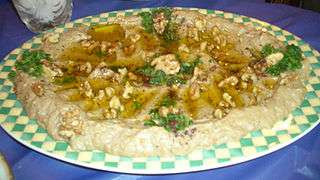 Baba Ghanoush بابا غانوج
Baba Ghanoush بابا غانوج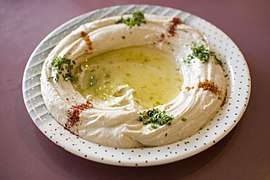 Hummus حمص
Hummus حمص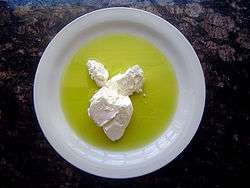 Labneh لبنة
Labneh لبنة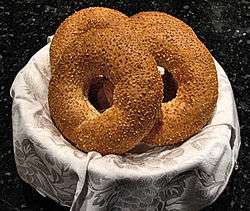 Ka'ak كعك - كحك
Ka'ak كعك - كحك Coffee قهوة
Coffee قهوة Halva حلاوة
Halva حلاوة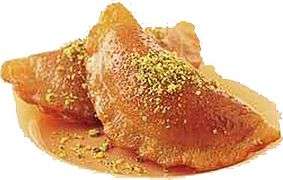 Qatayef القطائف
Qatayef القطائف Shish taouk شيش طاوك
Shish taouk شيش طاوك Toum تومية
Toum تومية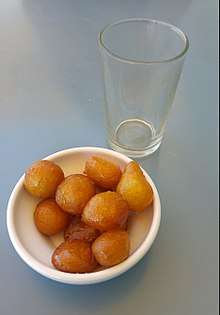 Awameh عوامة / Zalabieh زلابية
Awameh عوامة / Zalabieh زلابية_(cropped).jpg)
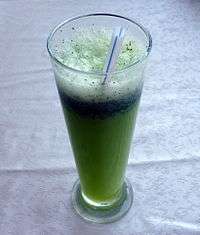 Limonana ليمون نعناع
Limonana ليمون نعناع.jpg) Harees هريس
Harees هريس
See also
References
- Flandrin, Jean-Louis; Montanari, Massimo; Sonnenfeld, Albert; Botsford, Clarissa (1999). Food: A Culinary History from Antiquity to the Present. New York: Penguin Books. ISBN 0-231-11154-1.
- Nasrallah, Nawal (2007). Annals of the Caliphs' Kitchens. Brill. pp. 121–122.
- Nasrallah, Nawal (2007). Annals of the Caliphs' Kitchens. Brill. pp. 182–184.
- The Oxford Companion to Sugar and Sweets
- Nasrallah, Nawal (2007). Annals of the Caliphs' Kitchens. Brill. p. 129.
- Nasrallah, Nawal (2007). Annals of the Caliphs' Kitchens. Brill. p. 221.
- Nasrallah, Nawal (2007). Annals of the Caliphs' Kitchens. Brill. p. 220.
- Nasrallah, Nawal (2007). Annals of the Caliphs' Kitchens. Brill. p. 229.
- "The Rise of Palestinian Food".
- Nabeel Y. Abraham. "Arab Americans", Encarta Encyclopedia 2007. Archived 2009-10-31.
- Zaouali, Lilia (2007). Medieval Cuisine of the Islamic World. University of California Press.
- "Desserts & Sweets in Arabia".
- "Daily Traditional Gulf Cuisine food recipes". Shahiya.com. Retrieved 2016-01-07.
- "Al Kabsa - Traditional Rice dish". Food.com. Retrieved 23 June 2012.
- "Hadhramaut continues to highlight Arabic presence in Malaysia - Culture & Art - 13/12/2013". KUNA.net. 2013-12-13. Retrieved 2016-01-07.
- "KUNA : Hadhramaut continues to highlight Arabic presence in Malaysia - Culture & Art - 13/12/2013". 158.50.10.7. 2013-12-13. Retrieved 2016-01-07.
- Grace Chen (2012-07-07). "Middle Eastern restaurants thriving in Malaysia". The Star. Malaysia. Retrieved 2016-01-07.
- National Dish of Egypt - Falafel
- "Umm Ali Recipe - Egyptian Bread Pudding".
- Shulman, Martha Rose (23 February 2009). "Couscous: Just Don't Call It Pasta". The New York Times. Retrieved 12 June 2017.
- Qarooni, Jalal (1996). Flat Bread Technology. Springer. pp. 84–. ISBN 978-0-412-08111-8.
- Smith, Andrew (2013). The Oxford Encyclopedia of Food and Drink in America. Oxford University Press. pp. 567–. ISBN 978-0-19-973496-2.
- MacVeigh, Jeremy (2008). International Cuisine. Cengage Learning. pp. 273–. ISBN 1-111-79970-9.
- "North African Cuisine." Archived 2016-04-03 at the Wayback Machine Jamaica Observer. Accessed June 2011.
- Mourad, Mazouz. "The Momo Cookbook." Archived 2011-09-19 at the Wayback Machine The Globalist. Accessed June 2011.
- Rozario, P. (2004). Libya. Countries of the world. Gareth Stevens Pub. p. 40. ISBN 978-0-8368-3111-5.
- Davidson, A.; Jaine, T.; Davidson, J.; Saberi, H. (2006). The Oxford Companion to Food. Oxford Companions. OUP Oxford. p. 1356. ISBN 978-0-19-101825-1.
- "Libya". Foodspring.com. Accessed June 2011.
External links

